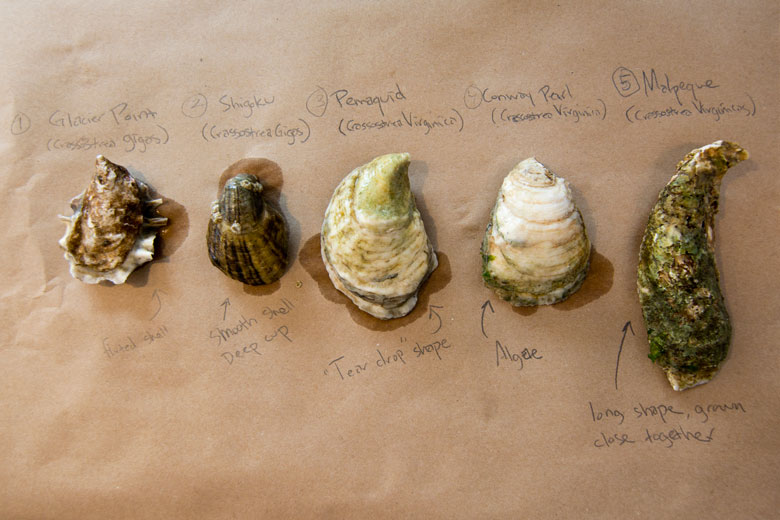A funny thing happens when you start talking about oysters — the conversations starts to sound a lot like wine. Words like terroir, water temperature, salinity start getting thrown around, comparisons between Maine and Massachusetts are made, and flavors are described as hints and notes.
When it comes down to the basics however, there are only five species of oysters. Everything else — where, when and how it’s grown — is what affects the flavor. And, unlike wine, the shells tell a very specific story. We grabbed eight oysters and asked two connoisseurs at Greenpoint Fish & Lobster Co. and Maison Premiere what they could tell us, based only on the shell.

The oyster: Pemaquid
Species: Crassostrea virginica (Virginicas, East Coast oyster, Virginia oyster, Atlantic oyster)
The East Coast oyster is the most popular of all types of oysters — according to the Smithsonian Marine Station, around 22 million pounds of these oysters are harvested a year. That’s 70 percent of all oyster harvests, which means if you’re eating a dollar special, they’re probably a Virginica. The Pemaquid is a classic East Coast variety. “Virginicas are known for their teardrop shape,” Greenpoint Fish & Lobster’s Adam Geringer-Dunn says, with shallow cups and a layered shell. Flavorwise, expect a balanced, briny, and savory oyster.

The oyster: Conway Pearl
Species: Crassostrea virginica
This is another classic Virginica oyster, with a slightly deeper cup. This might result from heftier tides, which tumble the oyster and rounds it out (you’ll see a more extreme example of this later). Notice the layers; you can typically tell how many growing seasons an oyster has gone through based on the layers formed. “The oyster grows in warmer waters, and then it stops in colder months when it hibernates,” Dunn says. You can also tell where the oyster is coming from based on the color of the shell; “Purple tends to be along Pacific, and green suggests it was growing higher up, among some algae.

The oyster: Malpeque
Species: Crassostrea virginica
No, the Malpeque isn’t a strange hybrid. Oyster shapes are affected not only by genetics, but also by growing conditions; nature versus. nurture, if you will. The Malpeque, despite it being a Virginica, has developed a long shell because of tight conditions. “Longer oysters tend to have been packed together,” Dunn says. “They’re the cheaper oysters of the bunch, and as you can see, it has less layers, which means it’s not as old.”

The oyster: Glacier Point
Species: Crassostrea gigas (gigas, Pacific oysters)
This is the ultimate Pacific oyster. Fluted shell? Check. Deep(ish) cups? Check. Originally from Japan, gigas are now the second most-harvested oysters, grown along both coasts in America. The Glacier Point, however, is not a wild giga oyster. “If you see wild gigas, they’re crazy,” Dunn says, with extremely fluted shells that give the oysters a coral reef-like appearance. Nevertheless, extreme fluting is a sign to expect creamier and fruitier notes, with variations of flavor based on terroir. Pacific oysters can also take on a purple hue, as previously noted.

The oyster: Shigoku
Species: Crassostrea gigas (gigas, Pacific oysters)
Please note the extremely deep cups and smooth surface, a product of tumbling that chips away at the gigas’ natural fluting. “Shigokus are the Barbies of the oyster world,” Dunn says. “They’re tumbled twice a day, which creates these incredibly deep cups and adds firmness to the meat.” The resulting flavor profile takes the creaminess of Pacific oysters and adds bite, with deep cups to easily hold the clean, briny oyster liquor.

The oyster: Kumamoto
Species: Crassostrea sikamea
Kumamotos are excellent beginner oysters, thanks to its sweet, mild and melon-tinged flavor profile. “The giveaway for a kumamoto would be its deep cups, shape, and size,” Krystof Zizka of Maison Premiere says. They fall on the smaller size of oysters, about two inches across. Don’t get them mixed up with a shigoku, which tend to have dark stripes along the super smooth shells; expect kumamotos to be just a tad larger and a bit more unruly in appearance, thanks to its fluted shells.

The oyster: Belon, European Flats
Species: Ostrea edulis
Typically the largest oysters on a menu, the European Flat has a history that dates back to the Romans. Unfortunately, it’s also one of the rarest species; thanks to disease, pollution and overfishing, the oysters are grown in only a few states with limited supply. Maine, one of the primary producers, only churns out 5,000 of these babies a year. To identify a belon, look for a large, flat and ridged shell; these can grow to be almost circular, and more than 20 cm large in diameter. “These are the most full-bodied oysters,” Zizka says. “These are deathly on the metallic flavors. My friend joked that it was like eating a lead pipe, that he turned green eating them.”

The oyster: Olympias
Species: Ostrea lurida
The Olympia oyster is the only real native West Coast oyster, Zizka says. It is particularly rare thanks to its long growing period — and distinctive size. Olympias are grown for some 4 years before they’re at market size, and still they can be the size of a nickel. “I’ve seen some the size of a dime,” Zizka says. Size, however, doesn’t matter. “They’re a big man in a small body,” Zizka says, noting the oysters’ super briny, sweet, metallic taste and celery-salt note.



